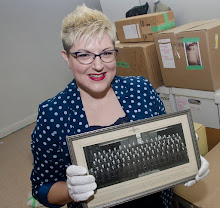Well, she's gone. Tracy's plane has take off for Vancouver and I'm left with a much quieter house. In typical Tracy fashion, I was right and she was wrong - her plane was yesterday, but we arrived at the airport for it today. Air Canada was super awesome, though, believe it or not, and moved her flight bookings over without even charging her an administrative fee. We were both shocked. Then she very nearly left her driver's licence at the check-in counter. I tried to change the American money that Gareth and I had left over from Skagway, but incredibly, despite being an international airport, Whitehorse Airport does not have a currency exchange. I shall have to take it to the bank and pay the fee.
As I said, we went to Skagway on Saturday. Skagway is in the Alaskan panhandle and was the staging ground for the Klondike Gold Rush back in 1898. Well, actually, it was the town of Dyea, from where you picked up the Chilkoot Trail. When the railway was built a year later, they based it in Skagway and that effectively killed Dyea. Skagway, today, is a tourist vacation staging ground. The cruiselines come in from Seatle and Vancouver, bringing thousands of tourists in during the summer. I'm not sure what goes on in town during the winter. The town isn't very big, probably not much bigger than 5000 people, and that's probably a generous estimate, and it has jewellery stores like Toronto has doughnut shops. But, tucked in and around them are some neat little places - like the Rock Shop, or whatever it's called, which sells rock samples and fossils. I bought a tiny trilobite (hah, I guess I'm starting a collection) for five bucks of the Order Ptychopariida, from Utah. At least I think that's it's Order. I'll have to double check. I almost bought a single Agnostida, which is the sort of 'proto' trilobite, but I liked the larger specimen I purchased more. Larger is relative, of course, as it's only about 8/10 of an inch in length. Where I'll mount it is another question, too.
Skagway's not all that interesting, really. Without the tourism, there'd be nothing much there at all. What is has is an extraordinary climate. Situated on what I guess is a glacial fjord, at sea level, surrounded by the very tall Coastal mountains and with the Pacific moderating the weather, it boasts a very temperate climate. The geology is such that you can move from alpine tundra to norther boreal forest, to temperate rain forest in a matter of minutes. We enjoyed dinner at the Red Onion Saloon, which is the less funky answer to Dawson's Bombay Peggy's. It was really nice to eat a fine pizza, though. Seriously. We also hit the liquor store and bought some REAL beer, since Whitehorse doesn't sell any. The Alaskan Brewery makes a charming Oatmeal Stout and I wanted to take it home with me. So I did. There was also fantastic milkshakes, coffee and peanut butter pie at a local cafe called Haven (or was it Heaven) Cafe off the main drag of downtown. Look for it, if you're there. YUM.
Dyea was very interesting, I must say. On a neighbouring fjord arm, it was humid and beautiful. Nearly fully returned to nature, there is little to mark the town's existence. A single false front stands on what had been main street, a straight line of coniferous trees marking the road in an otherwise random forest. Here and there are litter remains: rusted metal; roof sheets and wagon wheel frames. The forest has spent the last eighty years reclaiming the site. The town existed not even for a decade, going from boomtown to a population of three in the span of seven years. The train, bypassing the Chilkoot, made Dyea utterly pointless. We also visited the neighbouring Slide Cemetary, which with the exception of a tiny local burial adjoining the main yard, contains almost exclusively the graves of those who died in the April 3, 1898 snowslide. The obvious exception to this is "Noscitur shot in the mountains" a month later. Noscitur, in this sense, I think means "known to those who know him" or some such, as in its base verb form, "nosco", it means "to become acquainted with, get to know".
And then, yesterday, in carrying out the theme of dead mining settlements, we all went and hiked Miles Canyon until we found the remnants of Canyon City. Marked mainly by its midden heaps and vague structural outlines, Canyon City was a lot like Dyea. The walk along the canyon is stunning, even if it makes my fear of heights act up a bit, and took us about two hours in total. Originally, we'd planned to visit Kluane National Park, where Canada's tallest mountain, Mt. Logan, is located, but the weather was inclemant and we didn't want to drive an hour and a half to find it no better at the park. Hiking in the rain kind of sucks. No one was disappointed, though. Miles Canyon is beautiful and there were very nearly no other people on the trails. Despite the slow and lazy start, we had a great day.
